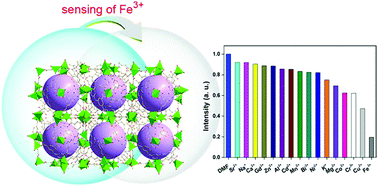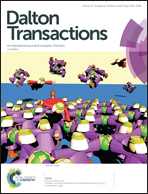Highly selective sensing of Fe3+ by an anionic metal–organic framework containing uncoordinated nitrogen and carboxylate oxygen sites†
Abstract
Fast and highly selective detection of trace amounts of metal ions has become one of the most urgent issues concerning public security and living systems. However, developing a highly efficient fluorescent sensor for metal ions still remains a great challenge. Metal–organic frameworks (MOFs) are a promising class of porous fluorescent sensors towards ion detection. Herein, the anionic MOF FJI-C8 based on the π-conjugated aromatic ligand H6TDPAT (2,4,6-tris(3,5-dicarboxylphenylamino)-1,3,5-triazine) containing uncoordinated nitrogen and carboxylate oxygen atoms was chosen as highly efficient sensor for selective detection of Fe3+. Due to the strong interaction between Fe3+ and Lewis base sites (uncoordinated nitrogen and carboxylate oxygen atoms), the high overlap between the emission spectrum of the anionic FJI-C8 and the absorption spectrum of Fe3+, and the good overlap of the excitation spectrum of the host material FJI-C8 with the absorption spectrum of Fe3+, FJI-C8 exhibited a high sensitivity (0.0233 mM of Fe3+) and extra selectivity (Ksv = 8245 M−1) for the rapid detection (less than 30 s) of Fe3+ with low usage (0.04 mg mL−1 of FJI-C8 suspension). To the best of our knowledge, this is the first example of a luminescent MOF chemosensor based on a trefoil ligand with the highest density of uncoordinated N and carboxylate O atoms for the highly selective detection of Fe3+. It is also crucial to note that this is a first time detection of Fe3+ using both FJI-C8 suspension and solid after filtration, and the results indicate that the detection of Fe3+ using the FJI-C8 suspension is better. This study will pave the way for designing luminescent MOF chemosensors for the detection of Fe3+ ion.

- This article is part of the themed collection: Spotlight Collection: MOF Sensors


 Please wait while we load your content...
Please wait while we load your content...